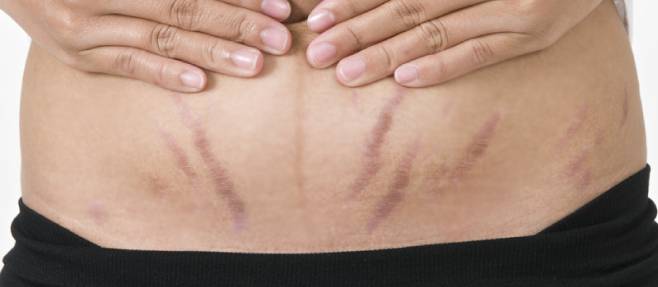Stretch Marks: Causes, Prevention & Treatments

Stretch marks are a type of scar that appears when skin quickly stretches or shrinks. They can appear as lines or streaks and may be lighter or darker in color than the surrounding skin. Learn what causes stretch marks, and how to prevent and treat them.
What Are Stretch Marks?
Stretch marks appear as streaks, bands or lines on the skin which differ in color from surrounding skin tissue. Sometimes, stretch marks feel ridged or indented. They can also be itchy or painful.
Stretch marks develop when skin quickly stretches or shrinks. This causes rupturing of collagen and elastin, two proteins which give skin its structure. Stretch marks are the scars which result from the healing process.
Not everyone experiences stretch marks with changes to their body weight. Some people are more susceptible to stretch marks than others.
Are There Different Types Of Stretch Marks?
Stretch marks may differ in their causes, color, shape or size. They can also differ depending on where they are on the body. Some are located in one specific area, such as the breasts, while other types are more widespread. Stretch marks are medically classified by color or cause.
Coloring: Stretch marks may be pink, red, purple, blue, dark brown, light brown or grayish in color.
Cause: Some stretch marks are pregnancy-induced, for example, while others are the results of thin skin.
Where Do Stretch Marks Occur?
Stretch marks are typically located on the thighs, buttocks, stomach, breasts, or upper arms. These are the areas where your body is most likely to store fat. As such, these areas are susceptible to rapid changes in size and shape.
What Causes Stretch Marks?
When skin rapidly stretches or shrinks, the stress hormone, cortisol, is produced. This hormone results in lost skin elasticity, causing collagen and elastin in the skin to rupture. As skin heals, stretch marks are the resulting scars.
The most common causes for the rapid weight gain and weight loss that leads to stretch marks includes the following:
- Adolescent growth spurts
- Pregnancy
- Rapid weight gain or weight loss due to illness or stress
- Rapid muscle growth with weight training
Medications that include cortisone, a steroid that mimics cortisol, may also lead to stretch marks. In addition, some syndromes and diseases include stretch marks among their symptoms.
Who is Most At Risk for Stretch Marks?
Not everyone who rapidly gains or loses weight develops stretch marks. Genetics play a large role. In addition, you’re more at risk for stretch marks if you were born a woman or if you have light, pale skin.
Can Stretch Marks Be Prevented?
There’s no sure way to prevent stretch marks, but there is evidence some techniques work better than others.
Regularly moisturizing with hyaluronic acid or products containing the herb centella are the most effective preventatives. These methods are even more effective when products are massaged into the skin, used every day, and used early in the formation of stretch marks.
In addition, maintaining a healthy, consistent body weight can prevent stretch marks from forming.
What Treatments Work for Stretch Marks?
Stretch marks frequently go away on their own over time. If they don’t, or if your stretch marks are painful or itchy, you may want to consider treatment. The following treatment options have been effective in some, but not all patients.
Tretinoin Cream
Tretinoin is a retinol which works by restoring skin’s collagen. This treatment works best when used on new stretch marks that are still pink or red. It may cause skin irritation in some people, and should never be used by pregnant women.
Fraxel Laser
Laser treatments heal stretch marks by improving blood flow to the area and stimulating collagen and elastin production. Fraxel, or fractional photothermolysis, uses a laser to heat the skin, triggering a healing response.
Pulsed Dye Laser
Pulsed dye laser therapy works best on light skin and new stretch marks. This treatment is less intense than Fraxel and may be more effective in treating discoloration due to stretch marks.
Microdermabrasion
Microdermabrasion may help minimize the appearance of older stretch marks. This treatment uses microcrystals to create an even layer of skin damage, which then heals as smoother and more evenly toned.
Microneedling
Microneedling also triggers a skin healing response, but does so by damaging the top layer of skin with several pricks of tiny needles. This technique is safer to use in skin color compared to some lasers
Chemical Peels
Chemical peels can be applied in varying degrees of intensity, but all work by chemically exfoliating the top layers of skin. Newer skin cells which are smoother and even replace the shed layers.
The above stretch mark treatments each require multiple visits, which steadily decreases the appearance of stretch marks over time. Your dermatologist may recommend using more than one treatment method as part of a comprehensive, stretch-mark treatment protocol.
It’s possible that your stretch marks can be minimized, but like other scars, never permanently removed. A consultation with a board-certified dermatologist can help you understand which treatment options are best for you.
